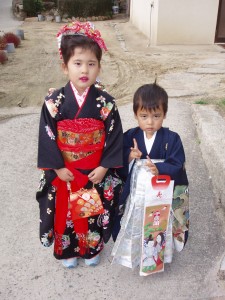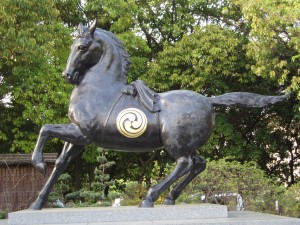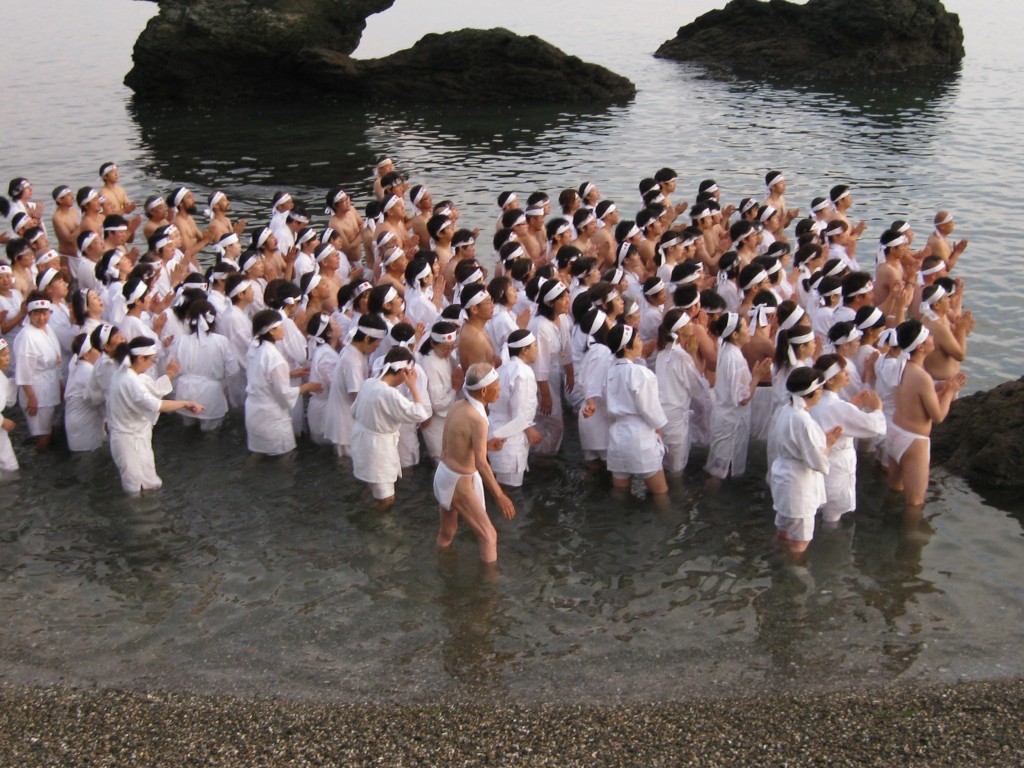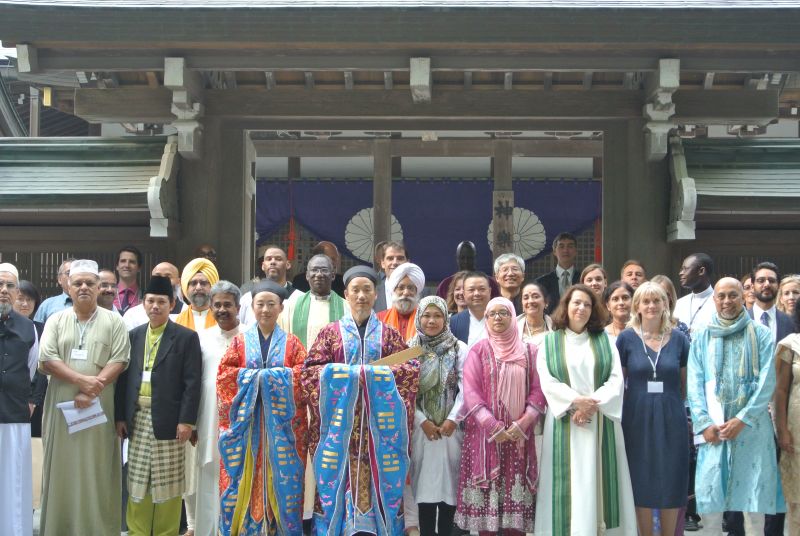
3, 5, 7 are lucky numbers in Taoism .
Not many people realise the debt Shinto owes to Taoism. It’s usually asserted that Shinto is the native religion of Japan, as if it is a purely indigenous creation. In fact, up to 70% of modern Shinto rituals are taken from Taoism (also written as Daoism).
Take the divination for instance, which comes from Taoism. Or take the 7-5-3 numerological symbolism which comes from Tao. Or even the mitsu tomoe, symbol of Shinto, which derives from the Taoist triad of heaven, earth and human.
In a youtube video the presenters put forward five general principles of Taoism, which also speak to the core values of ancient Shinto.
1 God and the universal way are beyond comprehension.
In Taoism it is often said that the Way has no name. Similarly in ancient Shinto the kami had no name. They were seen as local manifestations of a universal force that ran through the universe and were beyond understanding. Talking about the incomprehensible is meaningless. That’s why Shinto has no dogma and doctrine. Only as the Yamato state asserted its power through the means of strategically sited shrines did kami take on the names with which we are familiar today.
2) Good and evil are human perceptions, which do not exist in nature
Christians often attack Shinto as being amoral, and Catholic missionaries of the sixteenth century thought it akin to devil worship because the ‘gods’ of Shinto included malicious as well as benevolent aspects. Taoism, like Shinto, recognises that you can’t have good without evil, any more than you can have light without darkness, or truth without falsehood. There is no supreme good, and Amaterasu is not an almighty and all-knowing goddess.

Mitsu tomoe emblem on a Hachiman horse
3) Nature’s laws are heaven’s laws
Taoism looks to nature as the supreme teacher, and Shinto is rooted in kannagara, the way of nature. ‘Heaven follows the way of Tao, and Tao follows the laws of nature,’ says the Tao Te Ching. The consequence that both Tao and ancient Shinto draw from this are similar: ‘living in harmony with the earth, keeping your body healthy, taking care of your family, living a simple natural lifestyle – these are the ways to cultivate contentment, virtue and life,’ runs the Taoist ideal. Similar values are found in ancient Shinto, which put forward the ideals of sincerity, simplicity and naturalness.
4) Karma is self-inflicted
There is no divine punishment by some entity which judges our moral behaviour, but rather natural consequences that flow from our actions. Heaven and the ways of nature are impartial. Selfishness and wrong-doing however result in suffering. You reap what you sow.
(Taoism combines this with a belief in reincarnation, which I think differentiates it from Shinto, where life after death is left to Buddhism and ancestor worship.)
5) All is one
We are all part of one universe and share in the ultimate mystery. Words and the naming of things spread division, but silence and wonder are the natural response. ‘The unity is said to be the Mystery. Mystery of mysteries – the door to all wonders,’ says the Tao Te Ching. Take life as it is, lead a balanced lifestyle, keep healthy, contribute to the community, practise tai chi or aikido, strive for oneness, don’t cultivate the ego. Selflessness. Here Taoism merges with Shinto which merges with Buddhism. All is ultimately one.
***************
For a 8.30 minute long video of Five Beliefs that Make You Taoist, click here.

Purification rites like this derive from Taoist influence. Simple, healthy, life-affirming immersion in nature.

A multifaith meeting at Ise with Taoists front centre

Very informative article. Some of these beliefs remind me of Hinduism.
Very few people dispute the Sinitic cultural influence (not exclusively Taoist) that has helped shape Japanese religious beliefs, but on what basis can it be asserted that “Similarly in ancient Shinto the kami had no name.”? by the time that Japanese history becomes verifiable, the Yamato court has been full ascendant and worshiped a full pantheon of gods, to claim the contrary would be to claim some esoteric wisdom that the mass of the historical community has no access to. Even Ainu shamanism, which some look to for a pure ancient Shinto, has a pantheon of spirits with full personal names.
Ironically, despite your criticism of Motoori Norinaga, you are essentially falling for the Kokugakusha’s mythical idealized Japanese past, where they claimed that “sincerity, simplicity and naturalness” were the ancient way of the Japanese man (which had been perverted by foreign religions). For that matter, Taoism too has been essentialized and stripped of its real historical context. Whereas hard asceticism has been a common feature since it was developed, it has been reduced today to a “do your own thing” religion, with real modern Chinese Daoist lineage holders disregarded in favor of Western writers who can’t read Mandarin, much less Classical Chinese.
Good day, thank you for your comment. I’m surprised however that anyone who claims to be informed should be ignorant of the common assumption that kami have evolved over time from nameless vague supernatural beings to personified figures with names. The practice in times past was simply to refer to kami by their locality, and indeed this was still the case in many villages until the Meiji Restoration and the shrine amalgamation of the early twentieth century, when the central government set about installing imperial kami in place of nameless deities. In a paper entitled ‘Perspectives toward Understanding the Concept of Kami’, the Kokugakuin scholar Inoue Nobutaka writes that even as late as the 8th century when the Yamato court was busy promoting its pantheon, “it is quite rare to find jinja at which specifically named kami are enshrined, even in the cases of jinja mentioned in the Japanese classics. In most cases, the name of a jinja itself or the name of the place where a jinja was established is used as name of a kami. …. In later times, however, kami with names that are proper nouns were enshrined in many places because the spirits of the kami in Kyoto or Nara were divided and enshrined in local districts.’
Before making unfounded assertions, it’s well to do a little background reading yourself.
The afterlife (also referred to as life after death) is the belief that the essential part of an individual’s identity or the stream of consciousness continues after the death of the physical body.
What I find most attractive about taoism/ shinto is that these beliefs embrace dualities e.g. lightness / darkness, good / evil etc without the judgment / condemnation typical of more traditional religions i.e. any consequence of one’s actions is a natural outcome ( speaking as a “modified Catholic” -Shintoist / taoist). Although any attempts to “download” kami through language / intellectualization is discouraged, I can’t get around this sense of an all -pervasive cosmic force and its uncanny relationship with quantum field theory ( speaking as scientist). Also, thank you for the very illuminating thoughts in the previous posts.
Thank you for the input. You might find this post of interest concerning science and spirituality: http://www.greenshinto.com/2018/11/04/science-and-spirituality/
The parallels between Eastern philosophies and and modern physics never ceases to amaze me! In this case, the invisible all-pervasive force advocated by Taoism and Shinto can be compared to the dark energy the composes 73% of the universe. Also, the Higgs field in which the force carrying particle has been nick-named the “God particle”
No. Mitsudomoe is native to Japan. Derived from animal fangs 1000 BC. tomoe or magatama has been used as an antidote to evil spirits. It’s like a yin and yang siblo. But there is a difference. If Yin and Yang are two comma forms that become one, then magatama can have one comma, two comma, three comma, four comma, or even many comma. I think mitsudomoe and yin yang are too forced just because they are the same. Until now, the meaning of mistsudomoe “point three” has not been confirmed. And for the names Tao and To from Shinto because the Chinese who came to ancient Japan saw the ritual as similar to Taoism and named it similar to Tao or To which refers to gods.
Including the concept of the same deity does not mean the influence of taoism. Both Taoism and Shinto have animist roots. Taoism China’s earliest religion. Likewise, South America has the same beliefs as Taoism and Shinto. Likewise, in Indonesia there are “Kejawen” teachings, Sundanese Wiwitan, Kaharingan, Balinese Hinduism. I think the beginning of religion in the world is the same concept as taoism and shinto.
Thank you for the stimulating comment. I wonder on what basis you claim mitsudomoe is native to Japan? I would have thought it would come with the spread of Taoism from China and through the Korean peninsula. Animal fangs makes me think of magatama shape. Also I’m not familiar with all the religions you mention, but it would seem that shamanism is mankind’s earliest religion, and that Taoism and Shinto in particular can be viewed as post-shamanic.